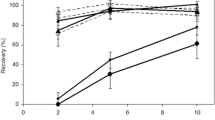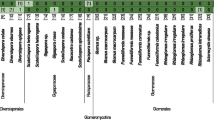Abstract
Root colonization by arbuscular mycorrhizal fungi (AMF) can be quantified by different approaches. We compared two approaches that enable discrimination of specific AMF taxa and are therefore emerging as alternative to most commonly performed microscopic quantification of AMF in roots: quantitative real-time PCR (qPCR) using markers in nuclear ribosomal DNA (nrDNA) and mitochondrial ribosomal DNA (mtDNA). In a greenhouse experiment, Medicago truncatula was inoculated with four isolates belonging to different AMF species (Rhizophagus irregularis, Claroideoglomus claroideum, Gigaspora margarita and Funneliformis mosseae). The AMF were quantified in the root samples by qPCR targeted to both markers, microscopy and contents of AMF-specific phospholipid fatty acids (PLFA). Copy numbers of nrDNA and mtDNA were closely related within all isolates; however, the slopes and intercepts of the linear relationships significantly differed among the isolates. Across all isolates, a large proportion of variance in nrDNA copy numbers was explained by root colonization intensity or contents of AMF-specific PLFA, while variance in mtDNA copy numbers was mainly explained by differences among AMF isolates. We propose that the encountered inter-isolate differences in the ratios of mtDNA and nrDNA copy numbers reflect different physiological states of the isolates. Our results suggest that nrDNA is a more suitable marker region than mtDNA for the quantification of multiple AMF taxa as its copy numbers are better related to fungal biomass across taxa than are copy numbers of mtDNA.


Similar content being viewed by others
References
Alkan N, Gadkar V, Coburn J, Yarden O, Kapulnik Y (2004) Quantification of the arbuscular mycorrhizal fungus Glomus intraradices in host tissue using real-time polymerase chain reaction. New Phytol 161:877–885. doi:10.1111/j.1469-8137.2003.00975.x
Badri A, Stefani FOP, Lachance G, Roy-Arcand L, Beaudet D, Vialle A, Hijri M (2016) Molecular diagnostic toolkit for Rhizophagus irregularis isolate DAOM-197198 using quantitative PCR assay targeting the mitochondrial genome. Mycorrhiza 26:721–733. doi:10.1007/s00572-016-0708-1
Bainard LD, Bainard JD, Newmaster SG, Klironomos JN (2011) Mycorrhizal symbiosis stimulates endoreduplication in angiosperms. Plant Cell Environ 34:1577–1585. doi:10.1111/j.1365-3040.2011.02354.x
Beaudet D, Terrat Y, Halary S, De La Providencia IE, Hijri M (2013) Mitochondrial genome rearrangements in Glomus species triggered by homologous recombination between distinct mtDNA haplotypes. Genome Biol Evol 5:1628–1643. doi:10.1093/gbe/evt120
Bécard G, Pfeffer PE (1993) Status of nuclear division in arbuscular mycorrhizal fungi during in vitro development. Protoplasma 174:62–68. doi:10.1007/BF01404043
Bianciotto V, Barbiero G, Bonfante P (1995) Analysis of the cell cycle in an arbuscular mycorrhizal fungus by flow cytometry and bromodeoxyuridine labelling. Protoplasma 188:161–169. doi:10.1007/BF01280367
Boddington CL, Dodd JC (1998) A comparison of the development and metabolic activity of mycorrhizas formed by arbuscular mycorrhizal fungi from different genera on two tropical forage legumes. Mycorrhiza 8:149–157. doi:10.1007/s005720050228
Börstler B, Raab PA, Thiéry O, Morton JB, Redecker D (2008) Genetic diversity of the arbuscular mycorrhizal fungus Glomus intraradices as determined by mitochondrial large subunit rRNA gene sequences is considerably higher than previously expected. New Phytol 180:452–465. doi:10.1111/j.1469-8137.2008.02574.x
Corradi N, Croll D, Colard A, Kuhn G, Ehinger M, Sanders IR (2007) Gene copy number polymorphisms in an arbuscular mycorrhizal fungal population. Appl Environ Microbiol 73:366–369. doi:10.1128/AEM.01574-06
Couillerot O, Ramírez-Trujillo A, Walker V, Von Felten A, Jansa J, Maurhofer M, Défago G, Prigent-Combaret C, Comte G, Caballero-Mellado J, Moënne-Loccoz Y (2013) Comparison of prominent Azospirillum strains in Azospirillum-Pseudomonas-Glomus consortia for promotion of maize growth. Appl Microbiol Biotechnol 97:4639–4649. doi:10.1007/s00253-012-4249-z
Covino S, Fabianová T, Křesinová Z, Čvančarová M, Burianová E, Filipová A, Voříšková J, Baldrian P, Cajthaml T (2016) Polycyclic aromatic hydrocarbons degradation and microbial community shifts during co-composting of creosote-treated wood. J Hazard Mater 301:17–26. doi:10.1016/j.jhazmat.2015.08.023
De la Providencia IE, Nadimi M, Beaudet D, Rodriguez Morales G, Hijri M (2013) Detection of a transient mitochondrial DNA heteroplasmy in the progeny of crossed genetically divergent isolates of arbuscular mycorrhizal fungi. New Phytol 200:211–221. doi:10.1111/nph.12372
Filion M, St-Arnaud M, Jabaji-Hare SH (2003) Direct quantification of fungal DNA from soil substrate using real-time PCR. J Microbiol Methods 53:67–76. doi:10.1016/S0167-7012(02)00225-7
Gamper HA, Young JPW, Jones DL, Hodge A (2008) Real-time PCR and microscopy: are the two methods measuring the same unit of arbuscular mycorrhizal fungal abundance? Fungal Genet Biol 45:581–596. doi:10.1016/j.fgb.2007.09.007
Gamper HA, Van Der Heijden MGA, Kowalchuk GA (2010) Molecular trait indicators: moving beyond phylogeny in arbuscular mycorrhizal ecology. New Phytol 185:67–82. doi:10.1111/j.1469-8137.2009.03058.x
Hausner G (2003) Fungal mitochondrial genomes, plasmids and introns. In: Arora D, Khachatourians G (eds) Fungal genomics: applied mycology and biotechnology. Elsevier Science, New York, pp 101–131
Isayenkov S, Fester T, Hause B (2004) Rapid determination of fungal colonization and arbuscule formation in roots of Medicago truncatula using real-time (RT) PCR. J Plant Physiol 161:1379–1383. doi:10.1016/j.jplph.2004.04.012
Janoušková M, Krak K, Wagg C, Štorchová H, Caklová P, Vosátka M (2013) Effects of inoculum additions in the presence of a preestablished arbuscular mycorrhizal fungal community. Appl Environ Microbiol 79:6507–6515. doi:10.1128/AEM.02135-13
Janoušková M, Püschel D, Hujslová M, Slavíková R, Jansa J (2015) Quantification of arbuscular mycorrhizal fungal DNA in roots: how important is material preservation? Mycorrhiza 25:205–214. doi:10.1007/s00572-014-0602-7
Jansa J, Smith FA, Smith SE (2008) Are there benefits of simultaneous root colonization by different arbuscular mycorrhizal fungi? New Phytol 177:779–789. doi:10.1111/j.1469-8137.2007.02294.x
Kiers ET, Duhamel M, Beesetty Y, Mensah JA, Franken O, Verbruggen E, Fellbaum CR, Kowalchuk GA, Hart MM, Bago A, Palmer TM, West SA, Vandenkoornhuyse P, Jansa J, Bücking H (2011) Reciprocal rewards stabilize cooperation in the mycorrhizal symbiosis. Science 333:880–882. doi:10.1126/science.1208473
Klironomos JN, Hart MM (2002) Colonization of roots by arbuscular mycorrhizal fungi using different sources of inoculum. Mycorrhiza 12:181–184. doi:10.1007/s00572-002-0169-6
Konvalinková T, Püschel D, Janoušková M, Gryndler M, Jansa J (2015) Duration and intensity of shade differentially affects mycorrhizal growth- and phosphorus uptake responses of Medicago truncatula. Front Plant Sci. doi:10.3389/fpls.2015.00065
Koske RE, Gemma JN (1989) A modified procedure for staining roots to detect VA mycorrhizas. Mycol Res 92:486–488. doi:10.1016/S0953-7562(89)80195-9
Krak K, Janoušková M, Caklová P, Vosátka M, Štorchová H (2012) Intraradical dynamics of two coexisting isolates of the arbuscular mycorrhizal fungus Glomus intraradices sensu lato as estimated by real-time PCR of mitochondrial DNA. Appl Environ Microbiol 78:3630–3637. doi:10.1128/AEM.00035-12
Kuroiwa T, Ohta T, Kuroiwa H, Shigeyuki K (1994) Molecular and cellular mechanisms of mitochondrial nuclear division and mitochondriokinesis. Microsc Res Tech 27:220–232. doi:10.1002/jemt.1070270304
Lee J, Young JPW (2009) The mitochondrial genome sequence of the arbuscular mycorrhizal fungus Glomus intraradices isolate 494 and implications for the phylogenetic placement of Glomus. New Phytol 183:200–211. doi:10.1111/j.1469-8137.2009.02834.x
Lekberg Y, Koide RT (2005) Is plant performance limited by abundance of arbuscular mycorrhizal fungi? A meta analysis of studies published between 1988 and 2003. New Phytol 168:189–204. doi:10.1111/j.1469-8137.2005.01490.x
Levina NN, Lew RR (2006) The role of tip-localized mitochondria in hyphal growth. Fungal Genet Biol 43:65–74. doi:10.1016/j.fgb.2005.06.008
Marleau J, Dalpé Y, St-Arnaud M, Hijri M (2011) Spore development and nuclear inheritance in arbuscular mycorrhizal fungi. BMC Evol Biol 11:51. doi:10.1186/1471-2148-11-51
Nadimi M, Stefani FOP, Hijri M (2015) The mitochondrial genome of the Glomeromycete Rhizophagus sp. DAOM 213198 reveals an unusual organization consisting of two circular chromosomes. Genome Biol Evol 7:96–105. doi:10.1093/gbe/evu268
Nadimi M, Stefani FOP, Hijri M (2016) The large (134.9 kb) mitochondrial genome of the glomeromycete Funneliformis mosseae. Mycorrhiza 26:747–755. doi:10.1007/s00572-016-0710-7
Newman EI (1966) A method of estimating the total length of root in a sample. J Appl Ecol 3:139–145. doi:10.2307/2401670
Oksanen J, Blanchet F, Kindt R, Legendre P, Minchin R, O’Hara R, Simpson G, Solymos P, Stevens M, Wagner H (2012) vegan: community ecology package. R Packag Version 2:0–4
Pelin A, Pombert JF, Salvioli A, Bonen L, Bonfante P, Corradi N (2012) The mitochondrial genome of the arbuscular mycorrhizal fungus Gigaspora margarita reveals two unsuspected trans-splicing events of group I introns. New Phytol 194:836–845. doi:10.1111/j.1469-8137.2012.04072.x
Pivato B, Mazurier S, Lemanceau P, Siblot S, Berta G, Mougel C, van Tuinen D (2007) Medicago species affect the community composition of arbuscular mycorrhizal fungi associated with roots. New Phytol 176:197–210. doi:10.1111/j.1469-8137.2007.02151.x
Püschel D, Janoušková M, Voříšková A, Gryndlerová H, Vosátka M, Jansa J (2017) Arbuscular mycorrhiza stimulates biological nitrogen fixation in two Medicago spp. through improved phosphorus acquisition. Front Plant Sci 8:390. doi:10.3389/fpls.2017.00390
Sasaki N, Suzuki T, Ohta T, Kawano S, Kuroiwa T (1994) Behavior of mitochondria and their nuclei during amoebae cell proliferation in Physarum polycephalum. Protoplasma 182:115–125. doi:10.1007/BF01403473
Sawers RJH, Svane SF, Quan C, Gronlund M, Wozniak B, Gonzalez-Munoz E, Chavez Montes R, Baxter I, Goudet J, Jakobsen I, Paszkowski U (2017) Phosphorus acquisition efficiency in arbuscular mycorrhizal maize is correlated with the abundance of root-external hyphae and the accumulation of transcripts encoding PHT1 phosphate transporters. New Phytol 214:632–643. doi:10.1101/042028
Sharma MP, Buyer JS (2015) Comparison of biochemical and microscopic methods for quantification of arbuscular mycorrhizal fungi in soil and roots. Appl Soil Ecol 95:86–89. doi:10.1016/j.apsoil.2015.06.001
Smith S, Dickson S (1991) Quantification of active vesicular-arbuscular mycorrhizal infection using image analysis and other techniques. Aust J Plant Physiol 18:637–648. doi:10.1071/PP9910637
Šnajdr J, Valášková V, Merhautová V, Herinková J, Cajthaml T, Baldrian P (2008) Spatial variability of enzyme activities and microbial biomass in the upper layers of Quercus petraea forest soil. Soil Biol Biochem 40:2068–2075. doi:10.1016/j.soilbio.2008.01.015
Spatafora JW, Chang Y, Benny GL, Lazarus K, Smith ME, Berbee ML, Bonito G, Corradi N, Grigoriev I, Gryganskyi A, James TY, O’Donnell K, Roberson RW, Taylor TN, Uehling J, Vilgalys R, White MM, Stajich JE (2016) A phylum-level phylogenetic classification of zygomycete fungi based on genome-scale data. Mycologia 108:1028–1046. doi:10.3852/16-042
Tamasloukht M, Séjalon-Delmas N, Kluever A, Jauneau A, Roux C, Bécard G, Franken P (2003) Root factors induce mitochondrial-related gene expression and fungal respiration during the developmental switch from asymbiosis to presymbiosis in the arbuscular mycorrhizal fungus Gigaspora rosea. Plant Physiol 131:1468–1478. doi:10.1104/pp.012898
Thonar C (2009) Synthetic mycorrhizal communities, establishment and functioning. Dissertation. ETH ZURICH. doi: 10.3929/ETHZ-A-005927506
Thonar C, Erb A, Jansa J (2012) Real-time PCR to quantify composition of arbuscular mycorrhizal fungal communities—marker design, verification, calibration and field validation. Mol Ecol Resour 12:219–232. doi:10.1111/j.1755-0998.2011.03086.x
Thonar C, Frossard E, Smilauer P, Jansa J (2014) Competition and facilitation in synthetic communities of arbuscular mycorrhizal fungi. Mol Ecol 23:733–746. doi:10.1111/mec.12625
Trouvelot A (1986) Mesure du taux de mycorhization VA d’un systeme radiculaire. Recherche de methodes d’estimation ayant une significantion fonctionnelle. Mycorrhizae Physiol Genet:217–221. doi:10.1177/004057368303900411
Vierheilig H, Schweiger P, Brundrett M (2005) An overview of methods for the detection and observation of arbuscular mycorrhizal fungi in roots. Physiol Plant 125:393–404. doi:10.1111/j.1399-3054.2005.00564.x
Wagg C, Jansa J, Schmid B, van der Heijden MGA (2011) Belowground biodiversity effects of plant symbionts support aboveground productivity. Ecol Lett 14:1001–1009. doi:10.1111/j.1461-0248.2011.01666.x
Wilson J (1984) Comparative development of infection by three vesicular-arbuscular mycorrhizal fungi. New Phytol 97:413–426. doi:10.1111/j.1469-8137.1984.tb03607.x
Acknowledgements
The study was supported by the Czech Science Foundation (project GA15-05466S) and by long-term research development programs RVO 67985939 and RVO 61388971. Furthermore, it was realized with the support of Ministry of Education, Youth and Sports of the Czech Republic, project NPU1 (LO1417) and the SoWa Research Infrastructure (LM2015075). The authors are grateful to Zuzana Münzbergová for consultations on statistics and to Petra Caklová for excellent technical assistance.
Author information
Authors and Affiliations
Corresponding author
Electronic supplementary material
ESM 1
(DOCX 1095 kb)
Rights and permissions
About this article
Cite this article
Voříšková, A., Jansa, J., Püschel, D. et al. Real-time PCR quantification of arbuscular mycorrhizal fungi: does the use of nuclear or mitochondrial markers make a difference?. Mycorrhiza 27, 577–585 (2017). https://doi.org/10.1007/s00572-017-0777-9
Received:
Accepted:
Published:
Issue Date:
DOI: https://doi.org/10.1007/s00572-017-0777-9




